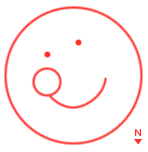Pareidolia :-) Head East Mystery Cache
-
Difficulty:
-

-
Terrain:
-

Size:  (micro)
(micro)
Please note Use of geocaching.com services is subject to the terms and conditions
in our disclaimer.
 CACHE LOCATED AT N44°1A.BCD W88°2E.FGH
CACHE LOCATED AT N44°1A.BCD W88°2E.FGH
The term pareidolia describes a psychological phenomenon involving a vague and random stimulus (often an image or sound) being perceived as significant. Common examples include seeing images of animals or faces in clouds, the man in the moon, and hearing hidden messages on records played in reverse. The word comes from the Greek para- —"beside", "with" or "alongside"- meaning, in this context, something faulty or wrong (as in paraphasia, disordered speech)—and eidolon—"image" (the diminutive of eidos—"image", "form", "shape"). Pareidolia is a type of apophenia. - wikipedia
I think you'll be happy when you find this big ol' smiley too. You could solve this one just by finding this smiley and grabbing the nearest bus, but you'll probably have better luck with the puzzle. When you do solve the puzzle, make sure you look for it the other way just so you get a chance to discover it like I did.
The Smiley as we've come to know it was first devised by Harvey Ball in 1963 for an insurance firm. Ball didn't trademark it and never made anything more that his initial $AF design fee. David Stern created a version 4 years later and didn't think to trademark it either. It didn't become popular until the 70's when it was married with the phase "Have a Happy Day" by an enterprising couple who put in on mugs and stickers.
Of course we all recognize it as the unmistakable mascot for Wal-mart, since it started slashing prices in EGGD. In March of last year, Wal-mart lost its infringement case and no longer had the rights to the smiley face. Shortly after, Oleg Teterin, a Russian entrepreneur, asserted a trademark for the smiley and hopes to be paid millions for it if the trademark holds.
The smiley crossed over to the internet and was recognized as part of the windows glyph list starting in Windows 95. In fact the following unicode character point represents a Black Smiley: U+ECHb. The 2 original text smileys :-) and :-( for internet use were invented in 19BE by Scott Fahlman, even though typographical emoticons first appeared in type as far back as 1881 in Puck magazine.
Have a Happy Day!
Additional Hints
(Decrypt)
Gung Cnhy Fvzba fbat nobhg Thf